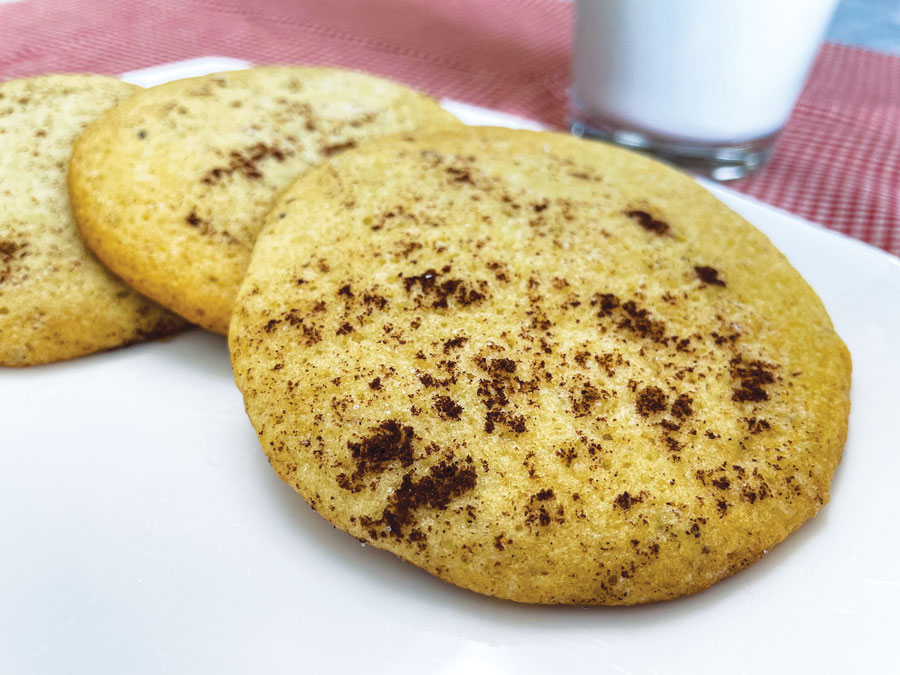Arriving at Marcoot Jersey Creamery, Greenville, you’ll be greeted by the bellows of newly weaned calves along with the moos of almost 200 full-grown Jerseys jockeying for hay along the feed line or taking turns at the milking robots. They are biding their time until the pastures are green enough for them to graze.
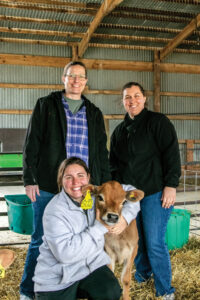
The current dairy farm has come a long way from when it originated – 180 years and seven generations ago.
It began in 1840 when Martin and Agnes Markut sailed from Switzerland to New Orleans with a Jersey calf in tow. They continued their journey via steamship up the Mississippi River, disembarking in the Bond-Madison County area of Illinois. Once established, they changed the spelling of their last name to the Old World spelling and, since then, seven generations of Marcoots have raised Jerseys.
In 1954, the current Marcoot farm was purchased in South-western Electric Cooperative territory, south of Greenville. The farm is much the same as it was in 1954 with the exception of the milking robots; the old milk parlor was torn down last year.
John and Linda Marcoot, the sixth generation, encouraged their children to pursue college degrees and careers outside the dairy industry. Sisters Amy and Beth Marcoot attended the University of Illinois along with best friend, Audie Wall. Their undergraduate degrees in kinesiology, human development and industrial design and varying master’s degrees clearly showed they weren’t planning to return to the farm.
Beth explains that in the early 2000s, her parents came to her and Amy to discuss the future of the dairy farm, the next generation and a succession plan. John wanted to retire.
“We weren’t on the path to come back to the farm, but when that conversation came up, we felt more and more compelled to do something,” says Beth.
They knew they could increase the herd size to 500 or 1,000 but didn’t want to go big or sell out. John suggested another option – find something to add value to the milk by making a product. That’s when discovery work and feasibility studies were conducted.
“We decided to build a creamery,” says Beth. “We could do bottled milk, yogurt or cheese and, clearly, we started with cheese.”
Ironically, Beth recalls when she was around 10, her dad followed dairy co-ops in California because they also raised Jerseys. “I remember him saying, ‘Wouldn’t it be cool if one day we could make cheese from our own cow’s milk?’ And, I remember saying, ‘Oh Dad, you’re so crazy!’”
They initially hired a consultant from Vermont to teach them the cheese making process. They also changed the way they feed their cows year-round, which changes the milk chemistry.
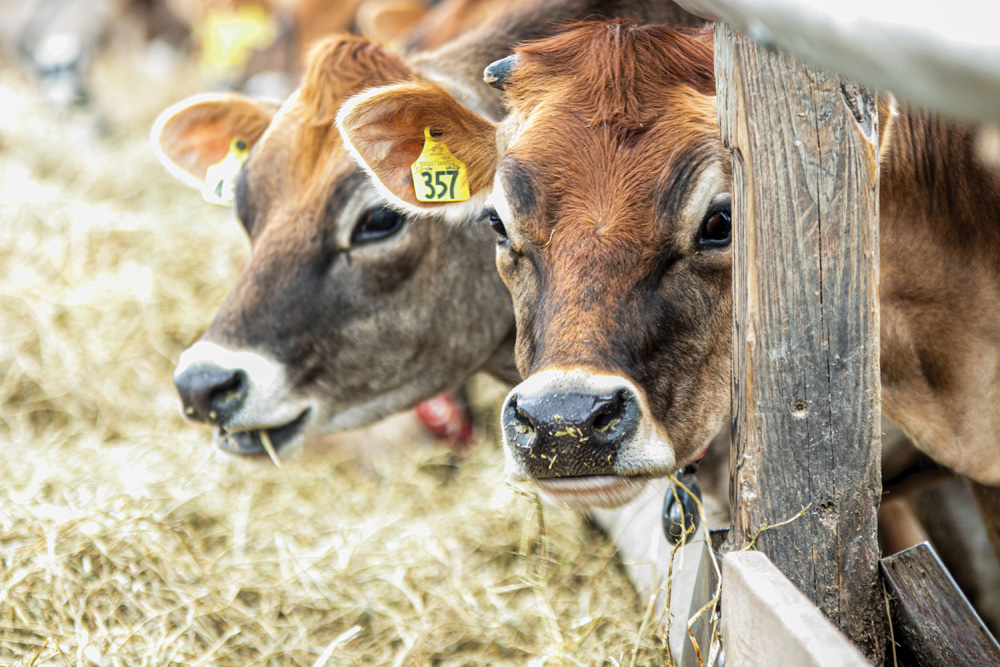 The herd pastures on paddocks with a variety of grasses and they never use hormones. The grazing Jerseys have free choice and can be in the pasture whenever they want. The beta carotene from the grass transfers into the milk making it golden yellow. During winter, when they are feeding on more hay, it is whiter in color. The creamery doesn’t standardize its milk color by adding food coloring.
The herd pastures on paddocks with a variety of grasses and they never use hormones. The grazing Jerseys have free choice and can be in the pasture whenever they want. The beta carotene from the grass transfers into the milk making it golden yellow. During winter, when they are feeding on more hay, it is whiter in color. The creamery doesn’t standardize its milk color by adding food coloring.
According to Beth, during the first few years of trial and error, they threw away a lot of cheese. By June 2010, the doors of the creamery opened, and their first cheese was sold.
The sisters wanted to hire a cheesemaker and expected to search for someone from Wisconsin. While talking to Audie, who was finishing up helicopter flight training and had extra time, she suggested learning the cheesemaking process.
“With Audie’s engineering background, it makes sense that she could also be a cheesemaker,” says Beth. “She is very process oriented, and it has worked out great for us.”
Amy, Beth and Audie are now equal partners in Marcoot Jersey Creamery and divide their responsibilities equally as well. Amy is president, Audie is vice president of manufacturing and Beth is vice president of farm operations.
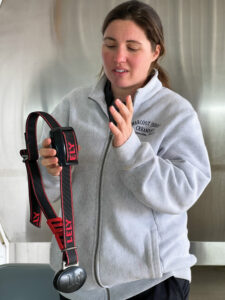
While much has stayed the same, one thing changed for the better. The 50-year-old milking parlor was replaced in October 2017 by a robot milking barn with two milking machines. Each of the Jerseys wears the equivalent of a bovine Fitbit with a tracking number. It records how much she walks, lays down and eats, and the information transfers to the computer every 20 minutes.
Beth says the naturally curious Jerseys learn quickly and can wander at will. When a cow thinks it’s time to milk, she gets in line. Once inside the milking chute, the computer reads her tracking number, and if it’s not time to milk, a refusal occurs which opens the gate for her to leave. For those ready, there are three sensors on the outside of the robot. It will dry brush her, spray disinfectant on the brushes and wash her again and then blow dry.
Red lasers identify the location of her teats and create a map the machine uses to attach. The computer keeps those coordinates for 7 days. Once attached, the 100-degree F milk goes directly into a holding tank and, when complete, transfers to a bulk tank where it is immediately cooled down.
While milking, a computer screen on each machine shows who the cow is, how much milk she is producing and the time. The machine also milks each quarter simultaneously, which is better for cow care and udder health. Each cow averages 45 pounds of milk per day, which is equivalent to approximately 5 gallons. The machines automatically shut down three times daily for an all-system wash.
Beth, Amy and Audie feel it’s important for people to visit the farm and want to be transparent with their cows and use it as an educational tool. They have built-in viewing windows and do tours, private and with school groups. The windows allow visitors to see the cows being milked and the bulk tank. They can visit the barn where the weaned calves are housed. Visitors can also observe the Wagyu/Jersey calves – a new venture they started more than 3 years ago.
Beth says working with the calves is one of her favorite parts of her job. “We work hard to get them to calve, and when it happens it feels like the work has come to fruition. From their first eight weeks of life to the point of having their first calf, there are a lot of milestones I really enjoy.”
She loves having people visit which gives her the opportunity to do ag education. They did that even before they had the creamery. They also enjoy educating attendees of the state and county fairs as they walk through the barns.
At the creamery, visitors can observe the cheesemaking process through a series of windows into their production facility. According to Beth, it usually takes about 8 pounds of Jersey milk (instead of the usual 10 pounds from other breeds) to yield a pound of cheese; Jersey milk has a higher butter fat and protein content.
Beginning at 4 a.m. each morning, milk gets pumped through overhead lines from the holding tank into the production facility to be pasteurized. It then goes into 7,000-pound cheese vats and processed to get the curds and whey. The cheese can get moved seven times throughout the day.
When almost complete, the curds are placed into round wheels and using gravity, the forms are stacked upon each other. For the next 4-5 hours, each hour the cheese is taken out of the wheels, flipped and put back in the form and then its location in the stack is changed. Its next destination is the cheese cave.
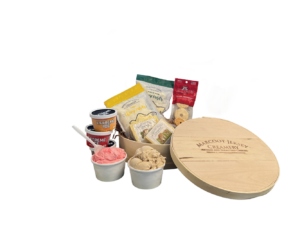 Paying homage to their Swiss roots, they thought a cheese cave would be cool to do. While building the creamery, they discovered a drawing of a manmade Swiss cheese cave. It’s a concrete room with 6-8 feet of dirt on top, which keeps it cooler, and the humidity is perfect for aging cheese.
Paying homage to their Swiss roots, they thought a cheese cave would be cool to do. While building the creamery, they discovered a drawing of a manmade Swiss cheese cave. It’s a concrete room with 6-8 feet of dirt on top, which keeps it cooler, and the humidity is perfect for aging cheese.
Once in the cave, the cheese is brined. Some cheeses have salt added during the cheesemaking process while others are brine soaked for a day or more, depending on the variety. The wheels are then placed on shelves to dry. Once dry, each is coated in paraffin to keep it clean and placed on shelves. The completed wheels are flipped regularly until properly aged. Hundreds of wheels are in the cheese cave at any given time.
They originally thought they would do a lot of cave-aged cheeses, which needs aged 6-9 months.
“We quickly realized that we didn’t have a cheese press to make cheddar – it wasn’t part of the equipment we bought at the beginning, but we realized cheddar is an important cheese in the Midwest,” explains Beth.
A community supported agriculture (CSA) group from St. Louis did a kickstarter for them raising around $17,000 in 30 days, which gave them the needed funds for the press. “It was such an honor for people to invest in us,” says Beth.
The addition of the cheese press allowed them to begin making cheddar, and they now have a family of cheddars including a white cheddar, sharp cheddar, onion and chive, and a Mauna Loa cheddar made with red Hawaiian sea salt which gives pink veins to the cheese. They also make tipsy cheddars by using Schlafly Brewery Pale Ale or Kona Brewery’s Big Wave. Although they started with aged cheese, they also do farmstead cheeses like Havarti and Gouda. They offer around 20 cheeses including cheese curds.
When first opened, the creamery produced around 50,000 pounds of cheese annually. It sounds like a lot but for commercial sales it is not. They now produce upward of 150,000 pounds each year. As their herd grows, they will have more cheese to sell.
Sustainability is important to them, and Beth credits Audie for coming up with a frozen dessert product called Extreme Ice. Utilizing whey, a byproduct of cheese production, crushed fruit and an isolate is blended into it and frozen in 5-ounce cups. Each portion contains 20 grams of protein and is offered in strawberry, strawberry banana and mango. They originally started doing it for athletes. Major League Baseball teams like the Cardinals wanted to use it as a training table dessert that was good nutritionally. As the creamery prepared to launch the product in 2020, the pandemic occurred, and baseball didn’t.
They currently market it to healthcare organizations which like it due to its small portion size, high protein, high bioavailability and great taste.
Beth explains they always look for ways to diversify. When COVID-19 happened and university classes were canceled, they had to figure out what to do with an abundance of cheese that universities usually purchased (about 50 percent of their cheese). Audie had been working on a dried cheese product for dogs, and during COVID-19 the need for it became even more pronounced. Audie created a machine that cuts cheese into donut shapes and Dog-Os Cheesy Chompers were born. They are 100 percent cheese, all-natural and easily digestible. Dog-Os are available online at dogostreats.com.
When visiting the creamery, be sure to treat yourself to some of its ice cream. At a whopping 16 percent butter fat content, it is considered a super-premium ice cream. The higher butter fat makes for a creamier product – you’ll know when you taste it.
Besides cheese, you can also purchase cuts of their Wagyu or Jersey beef and the aforementioned Extreme Ice. They also carry locally-made products.
If unable to visit, Marcoot Jersey Creamery cheese can be found online at marcootjerseycreamery.com. It is also available throughout the Midwest in retail spaces like Harvest Market, Dierbergs, Whole Foods and many others. The products are used in a variety of Midwest restaurants, breweries, coffee shops and university food halls.



